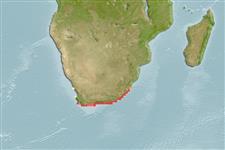Elasmobranchii (tubarões e raias) (sharks and rays) >
Carcharhiniformes (Ground sharks) >
Pentanchidae (Deepwater catsharks)
Etymology: Haploblepharus: haplos (Gr.), single or simple; blepharon (Gr.), eyelid, referring to simple structure of lower eyelid, which closes against upper eyelid to protect the eye. (See ETYFish); fuscus: Latin for dusky, dark or swarthy, probably referring to its overall drab-brown coloration. (See ETYFish).
More on author: Smith.
Environment: milieu / climate zone / depth range / distribution range
Ecologia
marinhas associadas(os) a recifes. Subtropical; 30°S - 35°S
Southeast Atlantic: just west of Cape Agulhas to southern Natal in South Africa (Ref. 5578). This species is sympatric with Haploblepharus edwardsii in the southeastern Cape region but there is at least partial microhabitat separation between the two - Haploblepharus fuscus occurs inshore while Haploblepharus edwardsii occurs in deeper water offshore (Ref. 244).
Tamanho / Peso / Idade
Maturity: Lm ? range ? - ? cm
Max length : 69.0 cm TL macho/indeterminado; (Ref. 244); 73.0 cm TL (female)
Descrição breve
Morfologia | Morfometria
Espinhos dorsais (total): 0; Raios dorsais moles (total): 0; Espinhos anais 0; Raios anais moles: 0. The largest shyshark, usually plain yellowish-brown above becoming just yellowish below; small light spots and indistinct brown saddles in some specimens (Ref. 5578).
Found close inshore on the continental shelf, often in shallow, rocky areas (Ref. 244). Feeds on lobsters, crabs and small bony fish (Ref. 5578). Oviparous (Ref. 50449). Readily kept in captivity (Ref. 244). Caught by shore anglers (Ref. 5578).
Life cycle and mating behavior
Maturidade | Reprodução | Desova | Ovos | Fecundidade | Larvas
Oviparous, laying 2 egg cases at a time (Ref. 11228). Embryos feed solely on yolk (Ref. 50449).
Compagno, L.J.V., 1984. FAO Species Catalogue. Vol. 4. Sharks of the world. An annotated and illustrated catalogue of shark species known to date. Part 2 - Carcharhiniformes. FAO Fish. Synop. 125(4/2):251-655. Rome: FAO. (Ref. 244)
Categoria na Lista Vermelha da IUCN (Ref. 130435)
Ameaça para o homem
Harmless
Utilização humana
Pescarias: pescarias de subsistência; peixe desportivo: sim
Mais informação
Idade/TamanhoCrescimentoComprimento-pesoComprimento-comprimentoFrequência de comprimentoMorfometriaMorfologiaLarvasDinâmica larvarRecrutamentoAbundânciaBRUVS
ReferênciasAquaculturaPerfil para aquaculturaEstirpesGenéticaElectrophoresesHereditariedadeDoençasProcessamentoNutrientsMass conversion
ColaboradoresFotografiasStamps, Coins Misc.SonsCiguateraVelocidadeTipo de nataçãoÁrea branquialOutras referênciasCérebrosVisão
Ferramentas
Relatórios especiais
Descarregue XML
Fontes da internet
Estimates based on models
Preferred temperature (Ref.
123201): 17.1 - 23.4, mean 20.8 °C (based on 49 cells).
Phylogenetic diversity index (Ref.
82804): PD
50 = 0.5625 [Uniqueness, from 0.5 = low to 2.0 = high].
Bayesian length-weight: a=0.00355 (0.00176 - 0.00714), b=3.09 (2.91 - 3.27), in cm total length, based on LWR estimates for this (Sub)family-body shape (Ref.
93245).
Nível Trófico (Ref.
69278): 4.0 ±0.63 se; based on food items.
Resiliência (Ref.
120179): Baixo, tempo mínimo de duplicação da população 4,5 - 14 anos (Fec assumed to be <100).
Fishing Vulnerability (Ref.
59153): Moderate to high vulnerability (49 of 100).
Nutrients (Ref.
124155): Calcium = 8.34 [1.79, 45.04] mg/100g; Iron = 0.369 [0.095, 1.072] mg/100g; Protein = 19.2 [16.1, 22.2] %; Omega3 = 0.121 [0.049, 0.280] g/100g; Selenium = 13.1 [3.8, 40.2] μg/100g; VitaminA = 40.7 [13.6, 130.3] μg/100g; Zinc = 0.589 [0.272, 1.236] mg/100g (wet weight);
